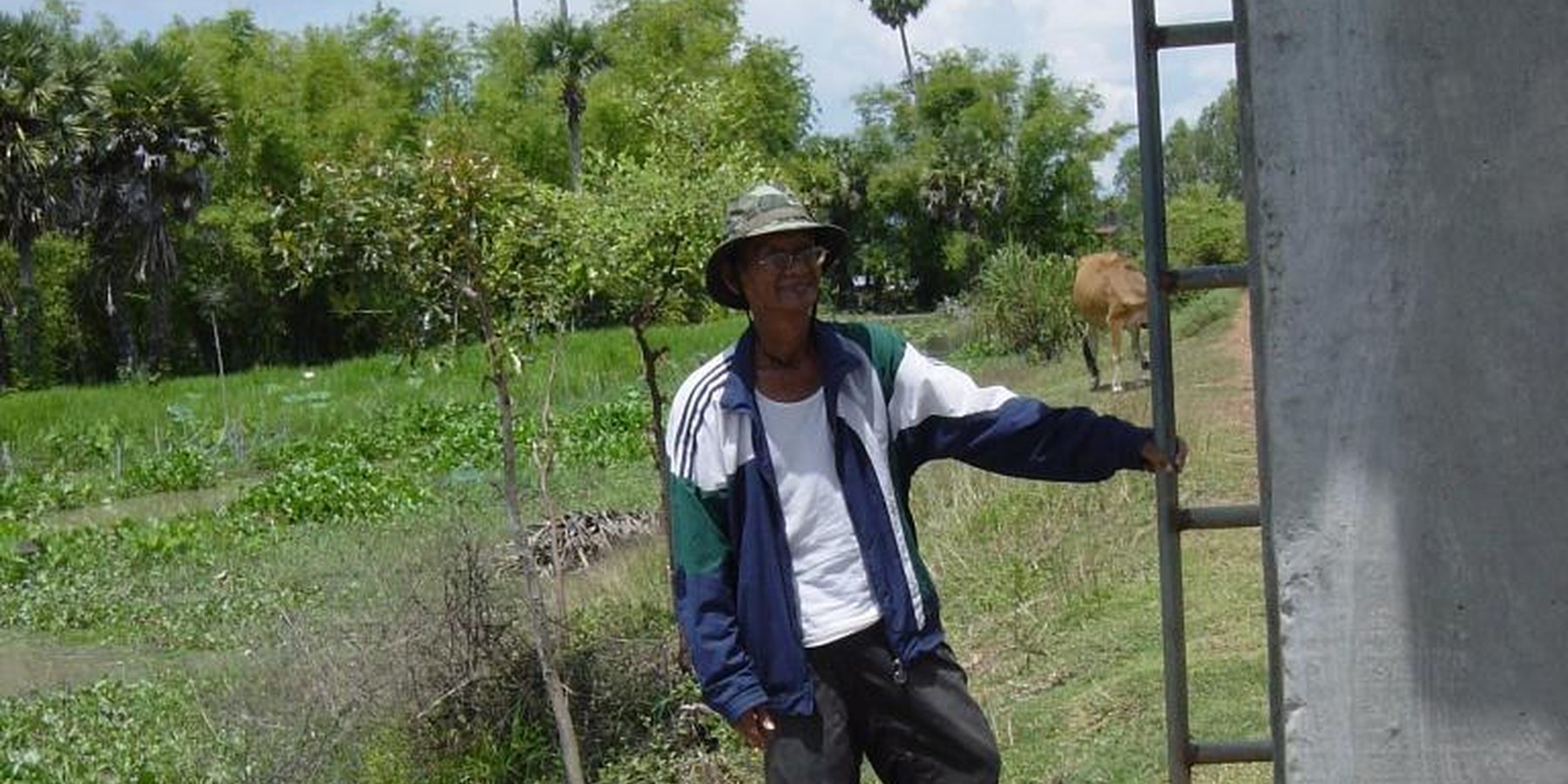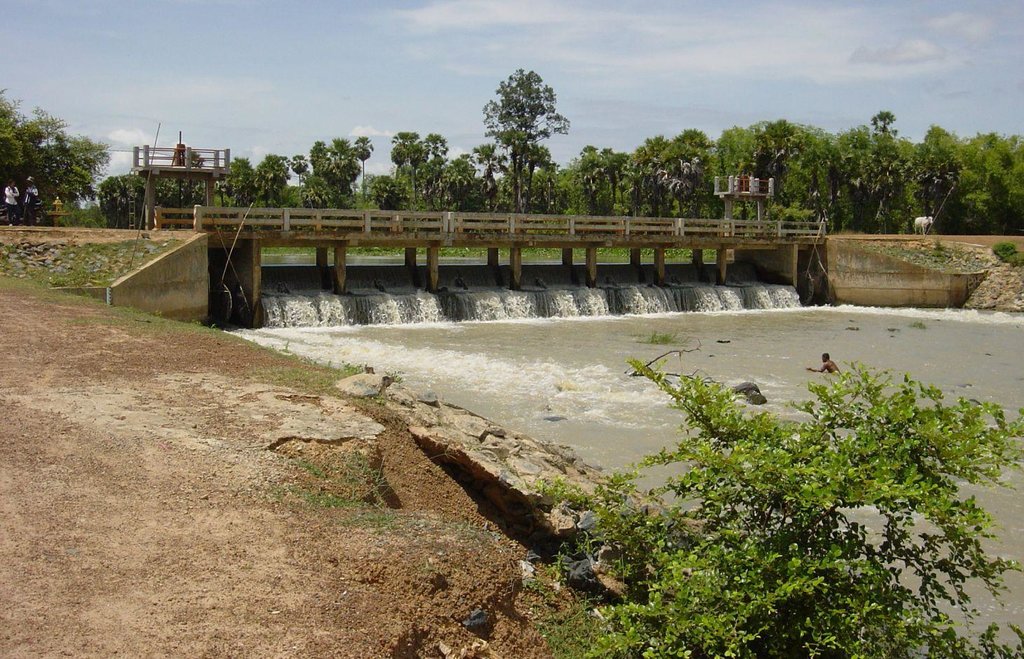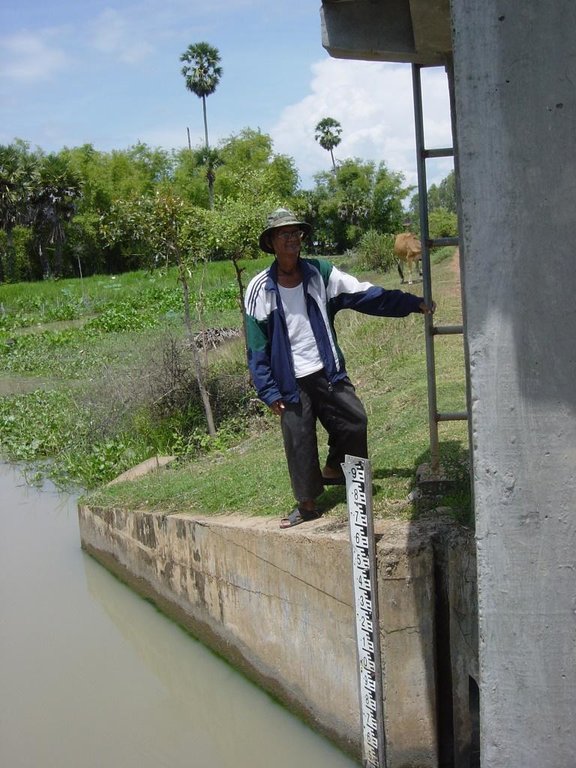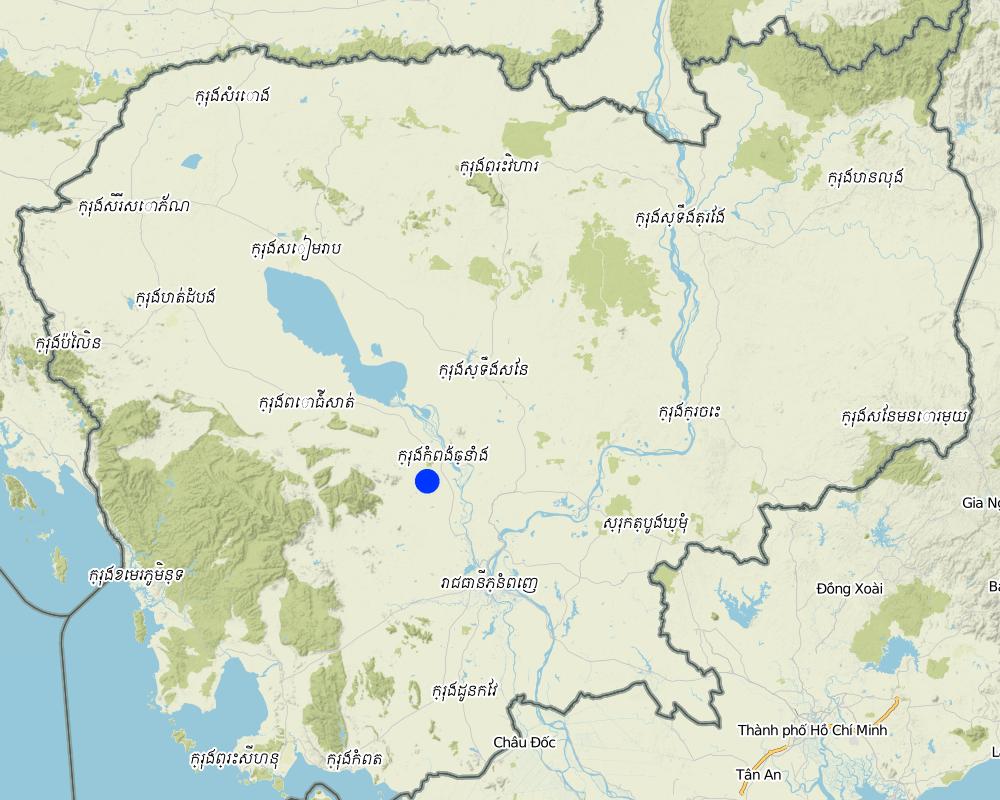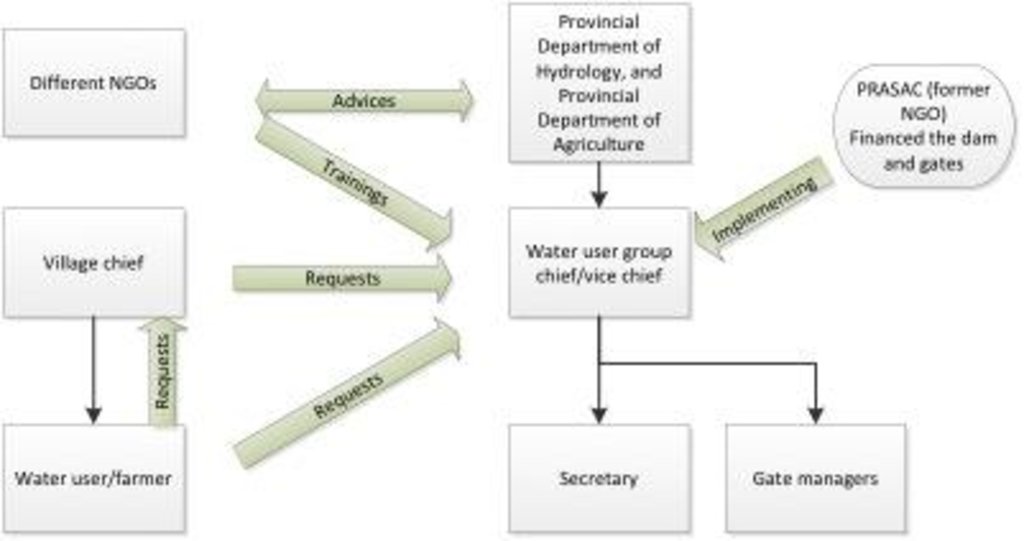Water user group [Cambodge]
- Création :
- Mise à jour :
- Compilateur : Stefan Graf
- Rédacteur : –
- Examinateur : David Streiff
ក្រុមប្រើប្រាស់ទឹក (Khmer)
approaches_2595 - Cambodge
Voir les sections
Développer tout Réduire tout1. Informations générales
1.2 Coordonnées des personnes-ressources et des institutions impliquées dans l'évaluation et la documentation de l'Approche
Spécialiste GDT:
Pith Khonhel
Local Agriculture Research and Extension Centre LAREC
Cambodge
Spécialiste GDT:
Bin Sreytouch
Society for Community Development in Cambodia SOFDEC
Spécialiste GDT:
Khun Lean Hak
kleanghak@yahoo.com / sofdec@camintel.com
SOFDEC/LAREC
Cambodge
Nom du ou des institutions qui ont facilité la documentation/ l'évaluation de l'Approche (si pertinent)
Society for Community Development in Cambodia (SOFDEC) - CambodgeNom du ou des institutions qui ont facilité la documentation/ l'évaluation de l'Approche (si pertinent)
Local Agricultural Research and Extension Centre (LAREC) - Cambodge1.3 Conditions relatives à l'utilisation par WOCAT des données documentées
Quand les données ont-elles été compilées (sur le terrain)?
09/09/2014
Le compilateur et la(les) personne(s) ressource(s) acceptent les conditions relatives à l'utilisation par WOCAT des données documentées:
Oui
1.4 Références au(x) questionnaire(s) sur les Technologies de GDT
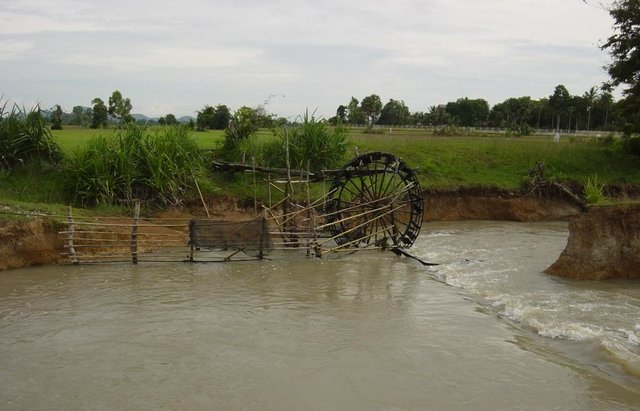
Irrigation of paddy fields using water-pumping wheels (Norias) [Cambodge]
Norias are water-pumping wheels made of bamboo which are used to irrigate paddy fields in order to increase the yield.
- Compilateur : Christoph Kaufmann
2. Description de l'Approche de GDT
2.1 Courte description de l'Approche
A water user group, led by a committee staff, decides about the distribution of the water during the dry season to plant dry season rice.
2.2 Description détaillée de l'Approche
Description détaillée de l'Approche:
Aims / objectives: During the Pol Pot regime, a dam was built to catch and store water from a temporary stream to irrigate rice during the dry season. The dam degraded over time, therefore it was repaired by a NGO to provide water for the cultivation of dry season rice. To manage it, a water user group was formed. The aim of this water user group is to have a fair distribution of the water hold by the dam among the farmers located downstream. The water user group is led by an elected committee staff of 5 members, who are the direct contact persons for the individual farmers and village chiefs, as well as for the provincial department of hydrology.
Methods: A former local NGO, PRASAC (now a microfinance institute), which repaired the dam and gates, organised a meeting with the three concerned villages to elect a committee responsible for the management of the water. The committee, consisting of a chief, a vice-chief, a secretary and an accounting, and two managers of the gates (each responsible for one gate) is responsible for the fair distribution of the water. The chief is the contact person for the village chiefs or the farmers themselves, who can request water. He is the contact person for the provincial department of hydrology as well.
Stages of implementation: The water user group was elected in 2002, when the dam was fixed. A short training was given to the committee which was then left on its own for the management. After tensions that occurred between farmers, the committee asked for advice in the provincial department of hydrology, which was passed off to CDRI (Cambodia Development Resource Institute), a local NGO. The CDRI conducted meetings and acted as a mediator, since then no tensions occurred anymore between water users as they introduced weekly schedules.
Role of stakeholders: The chief and vice chief are responsible for the distribution of the water. The two gate managers are controlling the gates.
2.3 Photos de l'approche
2.5 Pays/ région/ lieux où l'Approche a été appliquée
Pays:
Cambodge
Région/ Etat/ Province:
Kampong Chhnang
Autres spécifications du lieu :
Toeuk Phos
Commentaires:
A bit more than 100 ha are irrigated under this approach.
Map
×2.6 Dates de début et de fin de l'Approche
Indiquez l'année de démarrage:
2002
Date (année) de fin de l'Approche (si l'Approche n'est plus appliquée):
2003
2.7 Type d'Approche
- fondé sur un projet/ programme
2.8 Principaux objectifs de l'Approche
The Approach focused on SLM only
A fair distribution of water among the farmers, to produce rice during the dry season as well.
The SLM Approach addressed the following problems: The approach was designed to avoid conflicts on the use of water resources, and to allow rice production during the dry season.
2.9 Conditions favorisant ou entravant la mise en œuvre de la(des) Technologie(s) appliquée(s) sous l'Approche
disponibilité/ accès aux ressources et services financiers
- entrave
The staff works on a voluntary basis.
Treatment through the SLM Approach: The gate managers catch fish at the gates while releasing water which provides an income. The chief records the water levels behind the dam for the provincial department of hydrology, which provides an income to him.
cadre juridique (régime foncier, droits d'utilisation des terres et de l'eau)
- entrave
Conflicts between farmers about water use. The lower villages did not get enough water.
Treatment through the SLM Approach: A NGO, CDRI, acted as a mediator in the conflict. Since then no more tensions occurred as they introduced weekly schedules.
The existing land ownership, land use rights / water rights hindered a little the approach implementation Before there was open access to water, but no water was available since the dam was broken. Now there is water, but it is regulated.
3. Participation et rôles des parties prenantes impliquées dans l'Approche
3.1 Parties prenantes impliquées dans l'Approche et rôles
- exploitants locaux des terres / communautés locales
Villagers and village chiefs
The operation of the water gates needs a strong physical condition. The literacy of women is lower than the one of men. Only male staff.
Poor people were also involved, and use the water.
- Spécialistes de la GDT/ conseillers agricoles
- ONG
PRASAC implemented the water user group.
- gouvernement national (planificateurs, décideurs)
Provincial department of hydrology
3.2 Participation des exploitants locaux des terres/ communautés locales aux différentes phases de l'Approche
| Participation des exploitants locaux des terres/ communautés locales | Spécifiez qui était impliqué et décrivez les activités | |
|---|---|---|
| initiation/ motivation | aucun | |
| planification | aucun | |
| mise en œuvre | passive | The committee was elected, and acts until today. |
| suivi/ évaluation | aucun | |
| Research | aucun |
3.3 Diagramme/ organigramme (si disponible)
Description:
Organogram of the different stakeholders in the water user group in Toeuk Phos.
Auteur:
Stefan Graf (Centre for Development and Environment)
3.4 Prises de décision pour la sélection de la Technologie/ des Technologies
Indiquez qui a décidé de la sélection de la Technologie/ des Technologies à mettre en œuvre:
- les spécialistes de la GDT seuls
Expliquez:
The former NGO, PRASAC, fixed the dam that was constructed during the Pol Pot regime. The farmers had to be persuaded to plant dry season rice.
Decisions on the method of implementing the SLM Technology were made by by SLM specialists alone (top-down). The NGO decided that the water user group should be managed that way, organised an election and the same staff works since then.
4. Soutien technique, renforcement des capacités et gestion des connaissances
4.1 Renforcement des capacités/ formation
Une formation a-t-elle été dispensée aux exploitants des terres/ autres parties prenantes?
Oui
Spécifiez qui a été formé:
- exploitants des terres
- personnels/ conseillers de terrain
Formats de la formation:
- sur le tas
- zones de démonstration
Thèmes abordés:
Growing of dry season rice. The Provincial Dept. of Agriculture rented 100 ha and planted dry season rice. Since then the farmers plant it by themselves.
The staff was trained to work alone managing the water gates.
4.2 Service de conseils
Les exploitants des terres ont-ils accès à un service de conseils?
Oui
Spécifiez si le service de conseils est fourni:
- dans des centres permanents
Décrivez/ commentez:
In case the chief is confronted with a problem, he approaches the Provincial Department of Agriculture. The chief is then either redirected to a NGO or gets help by the Provincial Department of Agriculture.
Advisory service is inadequate to ensure the continuation of land conservation activities; The committee staff provides the water for free, the maintenance costs have to be financed by the provincial dept. of hydrology. PRASAC provided a financial reserve for the maintenance somewhere in the government, but neither the water user group chief nor the secretary/accountant know where this account is.
4.3 Renforcement des institutions (développement organisationnel)
Des institutions ont elles été mises en place ou renforcées par le biais de l'Approche?
- non
4.4 Suivi et évaluation
Le suivi et l'évaluation font ils partie de l'Approche? :
Oui
Commentaires:
Bio-physical aspects were regular monitored by project staff through measurements; indicators: Water level is monitored daily by committee chief, data reported to provincial dept. of hydrology.
There were few changes in the Approach as a result of monitoring and evaluation: Weekly schedules were established to avoid conflicts between villages. CDRI was working as a mediator.
There were no changes in the Technology as a result of monitoring and evaluation
4.5 Recherche
La recherche a-t-elle fait partie intégrante de l’Approche?
Non
5. Financement et soutien matériel externe
5.1 Budget annuel de la composante GDT de l'Approche
Commentez (par ex. principales sources de financement/ principaux bailleurs de fonds):
Approach costs were met by the following donors: national non-government (PRASAC): 100.0%; local community / land user(s) (Staff consists of volunteers )
5.2 Soutiens financiers/ matériels fournis aux exploitants des terres
Les exploitants des terres ont-ils reçu un soutien financier/ matériel pour la mise en œuvre de la Technologie/ des Technologies?
Non
5.3 Subventions pour des intrants spécifiques (incluant la main d'œuvre)
- infrastructures
| Spécifiez les intrants subventionnés | Dans quelle mesure | Spécifiez les subventions |
|---|---|---|
| Dam and gates | entièrement financé | |
Si la main d'œuvre fournie par les exploitants des terres était un intrant substantiel, elle était:
- volontaire
Commentaires:
the water user group staff works for free.
5.4 Crédits
Des crédits ont-ils été alloués à travers l'Approche pour les activités de GDT?
Non
6. Analyses d'impact et conclusions
6.1 Impacts de l'Approche
Est-ce que l'Approche a aidé les exploitants des terres à mettre en œuvre et entretenir les Technologies de GDT?
- Non
- Oui, un peu
- Oui, modérément
- Oui, beaucoup
They are able to produce food during the whole year, with up to 3 rice harvests a year on the same fields.
Est-ce que l'Approche a autonomisé les groupes socialement et économiquement défavorisés?
- Non
- Oui, un peu
- Oui, modérément
- Oui, beaucoup
Landless farmers have more work, as 3 rice harvests are produced per year.
Est-ce que l'Approche a amélioré les questions foncières et des droits d'utilisation qui entravent la mise en œuvre des Technologies?
- Non
- Oui, un peu
- Oui, modérément
- Oui, beaucoup
According to the committee chief, no more tensions occur now.
Did other land users / projects adopt the Approach?
- Non
- Oui, un peu
- Oui, modérément
- Oui, beaucoup
A fourth village joined the water user group.
Did the Approach lead to improved livelihoods / human well-being?
- Non
- Oui, un peu
- Oui, modérément
- Oui, beaucoup
The technology (the dam with gates) helped. But it would not work without the approach. It improved the food production, thus food security, and the livelihoods of the farmers.
Did the Approach help to alleviate poverty?
- Non
- Oui, un peu
- Oui, modérément
- Oui, beaucoup
It helped to alleviate poverty among the farmers owning land in the irrigated areas as they can produce more.
6.2 Principale motivation des exploitants des terres pour mettre en œuvre la GDT
- augmenter la production
Three harvests instead of only one.
- well-being and livelihoods improvement
Three harvests instead of only one.
6.3 Durabilité des activités de l'Approche
Les exploitants des terres peuvent-ils poursuivre ce qui a été mis en œuvre par le biais de l'Approche (sans soutien extérieur)?
- incertain
Si non ou incertain, spécifiez et commentez:
It is unclear what would happen if the dam needs maintenance but the provincial dept. of hydrology would not be willing to pay the maintenance costs.
6.4 Points forts/ avantages de l'Approche
| Points forts/ avantages/ possibilités du point de vue de l'exploitant des terres |
|---|
|
Improved livelihoods, three times more rice production and water vegetables as well as fish during the whole year. |
| No pumps are needed. |
| Farmers help each other with the water. (How to sustain/ enhance this strength: Regular meetings. ) |
6.5 Faiblesses/ inconvénients de l'Approche et moyens de les surmonter
| Faiblesses/ inconvénients/ risques du point de vue de l’exploitant des terres | Comment peuvent-ils être surmontés? |
|---|---|
| There is no money for maintenance activities. | |
| Nobody wants to work as committee staff as they don’t get any salary for this work. |
| Faiblesses/ inconvénients/ risques du point de vue du compilateur ou d'une autre personne ressource clé | Comment peuvent-ils être surmontés? |
|---|---|
|
No regular elections, nor bottom up improvements. Everything comes from outside. |
7. Références et liens
7.1 Méthodes/ sources d'information
- visites de terrain, enquêtes sur le terrain
- interviews/entretiens avec les exploitants des terres
Liens et modules
Développer tout Réduire toutLiens

Irrigation of paddy fields using water-pumping wheels (Norias) [Cambodge]
Norias are water-pumping wheels made of bamboo which are used to irrigate paddy fields in order to increase the yield.
- Compilateur : Christoph Kaufmann
Modules
Aucun module trouvé


